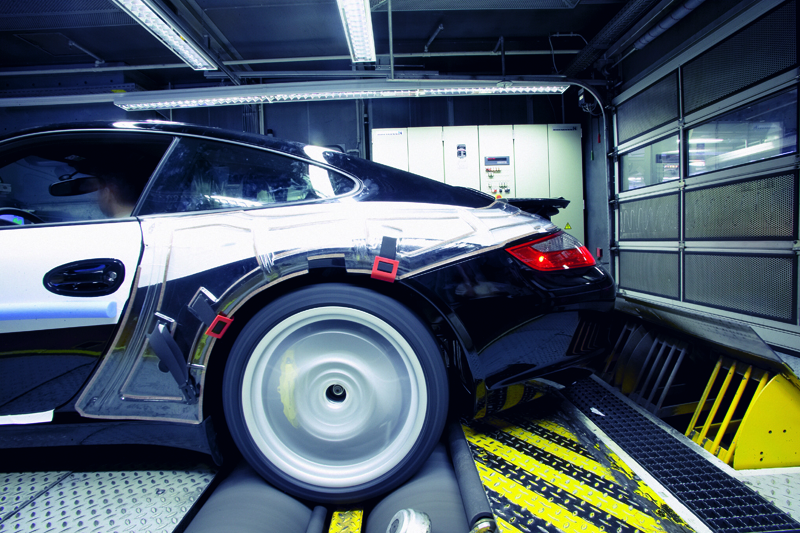| All mechanical systems suffer from friction loss. Power fed from the engine through the car’s drive system will be reduced by friction and converted into heat before it ever reaches the wheels. When the car is driven down the road, some of the fly-wheel or crank-shaft HP will be lost through the gear box, half shafts, universal joints, drive shaft bearings, wheel bearings, the rotational mass of the clutch/fly-wheel & wheels/brakes, alternator, air conditioning compressor and the rolling resistance of the tires. For a given mechanical system, those losses will generally stay close to a fixed percentage for most Porsches. |
 |
|
| You can make a reasonable calculation of the engine’s HP (on a car equipped with a manual transmission) fairly accurately by using some simple calculations. The average rear-wheel drive street car (with between 100-200HP) will lose about 17% of the engine’s fly-wheel HP through drive-train losses. Porsches lose (from the fly-wheel to the drive wheels) somewhere between 12-18% depending upon specific models and the age of the vehicle. Using 15% as a general rule correlates very closely to the actual factory figures. Four-wheel drive cars will have higher losses because of the extra differentials and other power train components involved in their four-wheel drive system. A reasonable estimate for a four-wheel drive car will show a loss of approximately 20-25% of its fly-wheel horsepower before reaching the drive wheels (newer four-wheel drive systems will lose less HP because of a more advanced design).Therefore, taking the HP reading from a chassis dyno and dividing it by .85 for a rear-wheel drive Porsche, will get you as close to the true engine horsepower of the car as you will ever get without removing the entire engine from the vehicle.Now that you know how to determine your car’s HP, what actually is a Chassis Dyno or a Rolling Road and how does it work? The car is driven onto the rolling road so the wheels are resting between two large steel rollers. The torque is measured at different speeds in exactly the same way that an engine dyno works. The only difference is that the torque is measured at the drive wheels rather than at the fly-wheel. A braking load is then applied to the rollers by using either a hydraulic or an electric drag system. A universal equation can then be used to calculate the HP at the tires. Most types of Chassis Dynos measure torque; the HP is then calculated from the formula BHP (brake horse power) = torque (ft/lb) x RPM/5252. This basic equation is the foundation for all engine design, development and tuning of modern cars. Since a Chassis Dyno measures power at the drive wheels, this avoids the inconvenience of having to remove the engine to test its HP. However, it means that the power figures obtained will be lower than the fly-wheel HP because of the frictional losses in the drive-train. This leads to one of the biggest sources of confusion, error and plain misinformation in the tuning industry today.
Two of the main methods for measuring HP that are used in the automotive industry are measurements taken from the fly-wheel of the engine or the measurement taken at the drive wheels. However, all major manufacturers use “fly-wheel HP” to determine and quote their HP figures. It is understandable that people who modify their engines with performance upgrades, want to know if their recently spent cash has actually increased their engine’s HP–and by how much. To know for certain if an engine modification has worked, requires a before and after dynamometer run to see if the performance upgrade has lived up to its claimed increase in performance. There is enormous pressure on chassis dyno operators to be able to quote fly-wheel HP rather than HP at the wheels. Most operators now run proprietary software systems which supposedly print out fly-wheel HP figures. These software systems are useful for estimating the power upgrades against the actual factory figures.
One of the problems with all dyno testing can be tire slip. Most of the chassis dynos use smooth steel rollers which over time get quite polished. The effects of tire slip are complex and you can get some unreliable HP figures from highly tuned engines. Another variable that can affect results is engine cooling. If there isn’t a large volume of cool air being supplied to the radiators, engine compartment and air intake system, there can be a considerable variance in the HP numbers from one dyno run to the next. This is especially important for turbo-charged engines since the innercoolers need large amounts of air to cool the charged air fed into the engine. When making a dyno run, other considerations that need to be taken into account are having tires with the same diameter and tire pressure, ambient temperature, humidity and barometric pressure to help eliminate potential variables. It becomes all too clear, that choosing a dyno operator who understands the complexities of obtaining accurate figures, is of critical importance
When it comes to engine performance upgrades or trying to determine the HP of an older Porsche, you have two choices. Either trust the supplier of the modification or builder of the engine, or you will need to do multiple dyno runs before and after any modification to see if the work done has actually lived up to its claims. |

